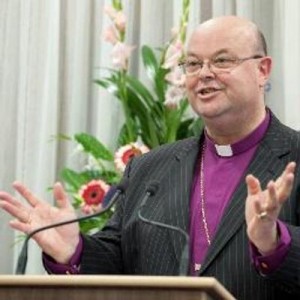12 April 2020
By Mary Bermingham
mary@TheCork.ie
Social distancing means avoiding individuals, it also means avoiding groups. Normal religious services are still taking place, but to empty pews with congregations watching by webcam, while some churches have closed entirely.
In Cork City the Chuch of Ireland Bishop of Cork, Cloyne and Ross, Paul Colton has published the sermon he had intended preaching.
File photo of Bishop Colton. At this time many people are seeking comfort in their religious beliefs.
‘The Sermon I would have Preached’ in St Fin Barre’s Cathedral, Cork but didn’t – Easter Day, 12th April 2020 – By the Chuch of Ireland Bishop of Cork, Cloyne and Ross, Paul Colton
They have taken away my Lord,
and I do not know where they have laid him.’
John 20.13b
Since I was ordained in 1984 I’ve only missed being at church on Easter Day one other time; I was sick. I’m not sick this year but like most of you, other than frontline workers, I am staying at home. I’m not gathering with other people outside my own household, as we have been asked to do.
‘Stay at home’ is the message. So I invite you to read at home this ‘Sermon I would have preached’ this Easter.
Naturally I am sad that, for the first time in my 21 years as Bishop, I am not preaching in St Fin Barre’s Cathedral, Cork this Easter. As the Lutheran pastor and writer Nadia Bolz-Weber tweeted ‘…it’s also now a pandemic of human disappointment … a lot of grieving on top of sickness.’ But needs must, and sadness is relative. So much is now on the back burner, and the one thing we all long and hope for is a return to normality, whatever that new normal will be.
Some sadness, such as mine today, is as nothing compared to the deep, heart-rending sorrow and struggle that many people are going through at this time, especially those who are ill – those with COVID-19 and those ill in other ways, as well as those who are bereaved.
Lives, families and communities here and the world over are in trauma – staying at home is a small price to pay, and I urge everyone to do it. ‘Just do it’ as the ‘ad’ says. ‘Stay at home.’
So this is the sermon I would have preached, if I could have been across the road in the Cathedral this Easter Day.
It is the strangest of feelings – surreal even – to be a participant in such obvious ‘history in the making.’ We would much rather not be history-makers of this kind, but, just as our forebears did what needed to be done to meet great challenges in their day, so we too will dig deep and discover the human spirit and resilience that is needed, together, to do what needs to be done now.
The Corona Virus has become, understandably, our all-consuming preoccupation; it has displaced the weather as the subject of Ireland’s small talk. We are all either dislocated from normality, or we find that our usual normality is hijacked by ways of doing things that we never before anticipated. Many are overwhelmed.
Our thoughts and emotions are like a swirling flood – a vortex – of confusion, stress, bewilderment, anxiety, frustration all tugging at the coat strings of our hope and pragmatism. We fluctuate between being resigned and unsettled. Many feel most intensely the experience of separation from loved ones, in spite of new technologies holding us together. It is not the same. As someone said to me ‘I miss the hugs most of all’ This intense separation from human contact outside the home is what characterises the angst of this time, especially for those who live alone.
As far as our religious faith is concerned this experience is multi-faceted too; it is both renewing and unsettling of faith for starters. We are renewed – in our desire to pray and to be prayed for. We are unsettled about the many unknowns and mysteries. We have big questions.
For me, celebrating in this unusual way this Easter morning, this year, and for us all, I see across the centuries common ground with the experience and the message of that first Easter morning.
All week we have been retracing the steps of Jesus and his community of followers in the last days and hours of his life. We have been drawn in, not only to their world, but also into the world of their opponents, questioners, enemies, also the authorities and officials, civic and religious, and there have been individuals and great crowds drawn in too, sometimes on the sidelines, other times central to what was going on.
Elicited and manifest have been every emotion and human characteristic under heaven – profound love, false promise, weakness, intense loyalty, failure, betrayal, cowardliness, watchfulness, neglect. belief and disbelief … these and more; they are all there.
And we come to this morning. To say the least, looking at all the accounts, it was a morning of strange events. Parts of the accounts are extraordinary and puzzling: strange goings-on. We raise our eyebrows and there’s much to reflect on and to study with the help of biblical scholars There were questions, mixed emotions, doubts and convictions, confusion, individual loneliness as well as collective concern. We are told of fear and trembling, of every emotion and reaction: surprise, shock, grief, fear, terror, disbelief, hope, and intense love.
There is darkness, then half-light and mystery.
There is lots of activity. Some of it purposeful, some of it futile; people running around to one end or another – some ‘headless chickens’ and some pragmatists. Cross words are spoken. There are words of love, assurance and resilience too.
In St Mark’s account the women are so afraid that they are stunned into silence. They say nothing. Numb! Perhaps that is how we are too.
All of this is why I chose the text I did this morning from St John’s Gospel:
They have taken away my Lord,
and I do not know where they have laid him.
John 20.13b
The emotional intensity of Mary’s question seems to sum it all up in that one person and that one exchange. We have seen such ‘summing up’ in recent days too in hosts of ways: the man on the garden bench looking in the hospital window to say goodbye to his dying brother is one that many refer to.
All of the accounts of the first Easter leave us with questions but they also proclaim what Christians the world over repeat today with confidence, with joy and with hope:
Christ is risen!
Christian’s have always believed that the good news of Good Friday and Easter is a message for every time and place and that supremely, taken together with the incarnation the birth of Jesus as they are meant to be, two sides of the one coin, the good news is about light and life. Referring to the Word of God, Jesus, as ‘the life’ and ‘the light of all people’ Saint John tells us that the ‘… light shines in the darkness, and the darkness did not overcome it.’ (John 1.5) That is what shining the lights in the darkness as we did in countless numbers here in Ireland last evening was such a powerful articulation of our hope.
In his Gospel, Saint John also invites us to see the events we commemorate this weekend – the crucifixion and resurrection – as signs of God’s love for us. It is this theme for which St John’s Gospel is perhaps best known – God’s love: ‘For God so loved the world that he gave his only Son, so that everyone who believes in him may not perish but may have eternal life. (John 3.16)
In Mary’s deeply agonised question this Easter, we see ourselves, perhaps, during these days:
They have taken away my Lord,
and I do not know where they have laid him.
John 20.13b
Today as we proclaim that ‘Christ is risen!’ we are invited again to discover the timelessness of the first Easter experience. We are invited to embrace and hold on to the the enduring truth of the Easter message, It gives us confidence and hope: God’s presence with us, the message of God’s unchanging and immovable love for us which, like Jesus himself, is the ‘same yesterday today and forever.’



